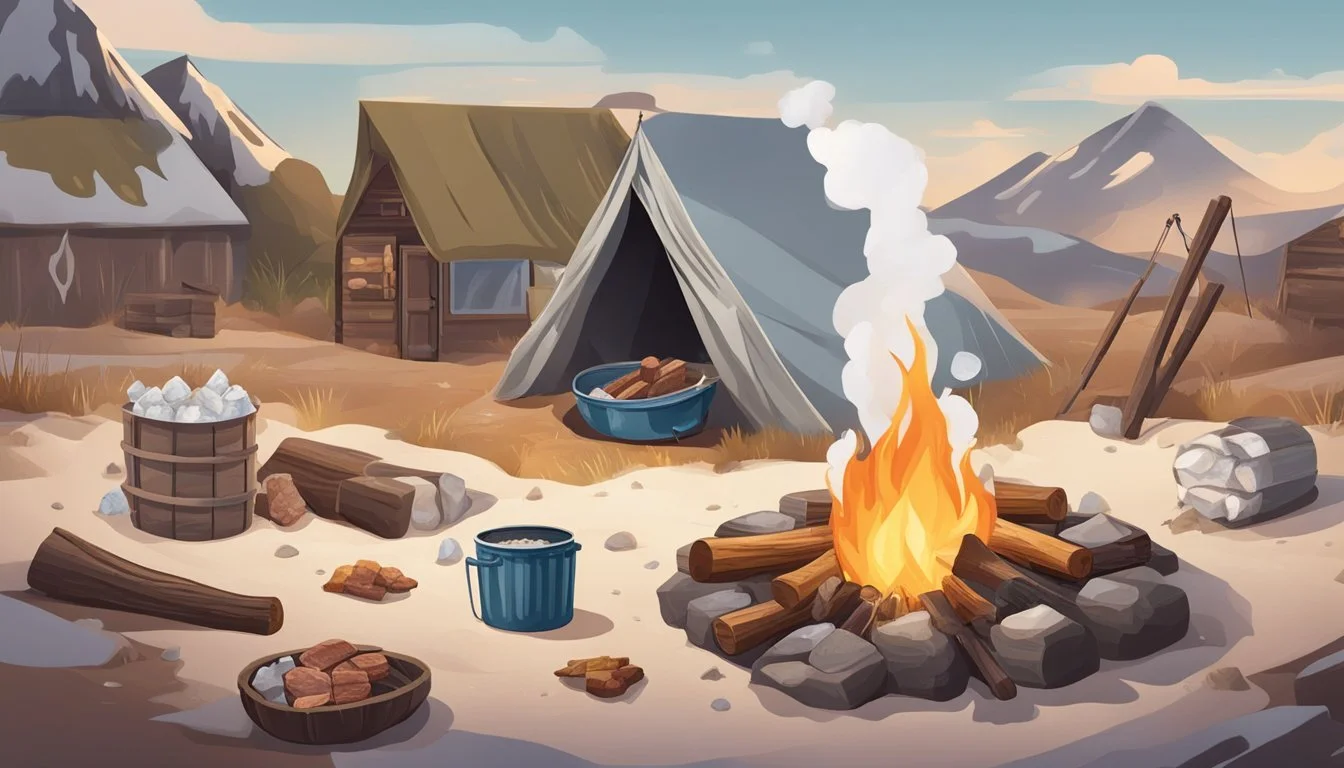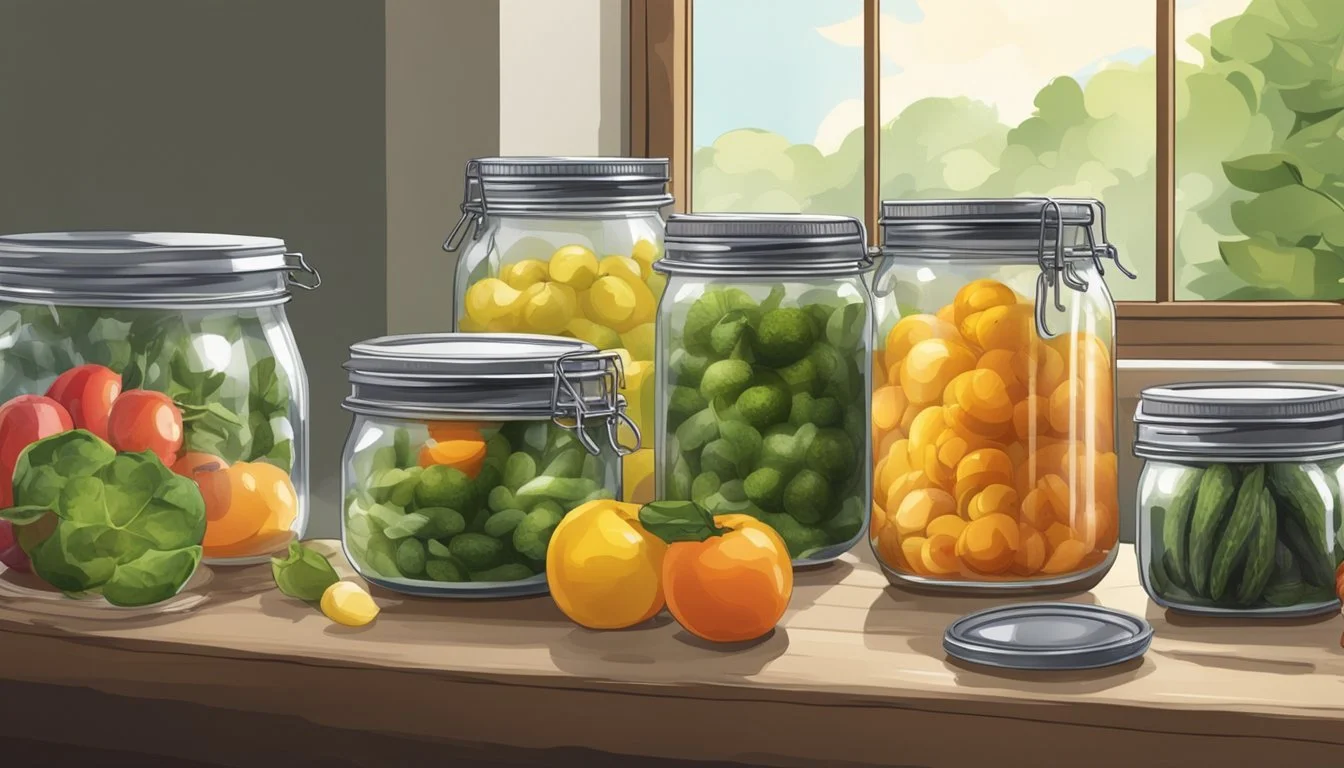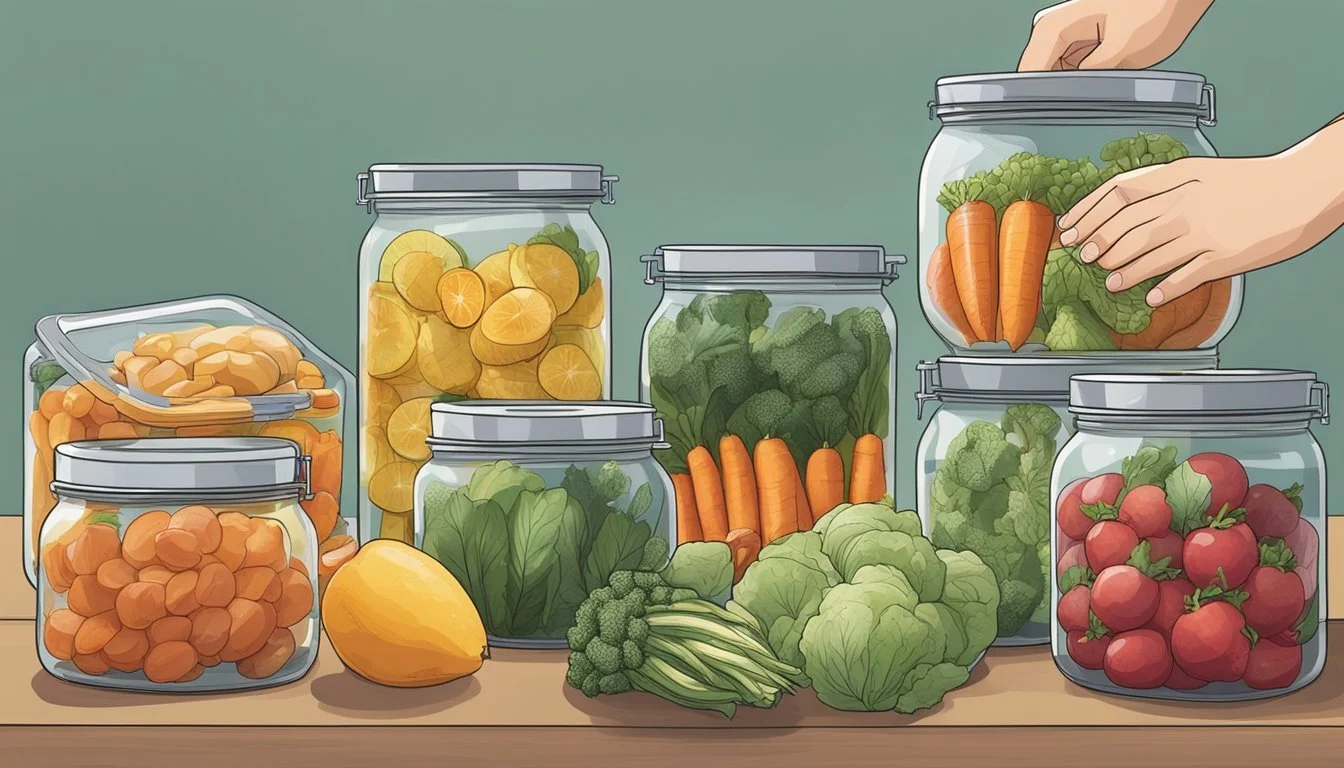The Techniques for Preserving Food on the Trail
Essential Tips for Outdoor Enthusiasts
Preserving food while on the trail is crucial for maintaining both the safety and quality of the meals hikers and backpackers consume. The challenge arises from the need to carry lightweight provisions that can withstand the absence of refrigeration and the rigors of outdoor excursions. Techniques have evolved from historical practices to modern methods that ensure nourishment and allow trekkers to enjoy a variety of flavors without compromising on health.
Food preservation on the trail primarily involves selecting the right food items and employing methods that inhibit the growth of microorganisms responsible for food spoilage and foodborne illnesses. Dry foods such as nuts, seeds, and dehydrated vegetables are standard as they are less perishable and significantly lighter to carry. Lean meats can be treated by smoking, curing or drying into jerky, making them safe for consumption over extended periods. The use of vacuum-sealed packaging also extends the shelf life of foods by removing air that harbors bacteria, while preserving the taste and nutritional value.
Understanding Food Preservation
Food preservation on the trail is crucial for maintaining the safety, nutritional value, and freshness of food. The key is to control factors that lead to spoilage and to use methods that help in retaining the food's original qualities.
Fundamentals of Food Spoilage
Food spoilage is the result of chemical changes that occur over time, often accelerated by environmental factors. Moisture, oxygen, and microorganisms are primary catalysts for these changes. Effective preservation techniques aim to reduce or eliminate these elements to extend the shelf life of food products.
The Role of Moisture and Microorganisms
Moisture is a critical factor in the survival and proliferation of microorganisms, which include bacteria, yeasts, and molds. Removing or binding moisture through methods like drying and salting can significantly slow down or prevent the growth of these spoilage-causing agents. On the other hand, microorganisms are not universally detrimental; some, like those involved in fermentation, are harnessed for beneficial preservation effects.
Preserving Nutritional Value and Freshness
Maintaining the nutrients and freshness of food is as important as preventing spoilage. Preservation methods should minimize nutrient loss and preserve as much of the original taste and texture as possible. For example, drying can concentrate flavors while freezing can retain vitamins and minerals. However, certain methods might reduce some nutrient availability, so it's essential to choose the appropriate technique based on the specific food item and the desired outcome.
Drying and Dehydration Techniques
Drying and dehydration are effective methods for preserving food for extended periods, particularly useful for activities such as backpacking and camping where lightweight, durable nourishment is essential.
Sun Drying and Its Efficacy
Sun drying is the simplest form of removing moisture from food, using the natural heat and light from the sun. This technique is most suitable for fruits like apples, peaches, and grapes. However, it requires consistent, warm temperatures and low humidity to be effective. Foods are typically pre-treated to prevent spoilage and spread on trays or screens to dry evenly. The key is ensuring adequate air circulation around the food for uniform drying.
Using Dehydrators for Controlled Drying
Dehydrators offer a more controlled environment for food dehydration, allowing for consistent heat and airflow that lead to a more predictable drying process. They come in various types, but all function to efficiently remove moisture. Using a dehydrator, one can preserve a wide range of foods including dried fruits, vegetables, and meats. The temperature can be tailored to the specific food being dried, a crucial factor in maintaining food quality.
Making Jerky: A Popular Dried Meat Option
Jerky is a popular dried meat that's both nutritious and lightweight, making it ideal for trail sustenance. Making jerky entails slicing meat thinly, marinating it for flavor, and then drying it at low temperatures. The goal is to remove moisture content without cooking the meat. Dehydrators are often used for this process, but an oven can also serve in a pinch. The end product is protein-rich jerky that can last for months if stored properly, providing a durable food source for long treks.
Salt, Sugar, and Smoking Methods
In historical and modern preservation methods on the trail, salt, sugar, and smoking play pivotal roles in extending food shelf life and enhancing flavor.
Salting: The Importance of Salt in Preservation
Salting, or salt curing, is a preservation technique that involves applying salt to foods, especially meats like bacon and salt pork. The salt acts to draw out moisture through the process of osmosis, creating an environment where bacteria struggle to survive. This dehydration effect, combined with salt's inherent antibacterial properties, makes salt curing a reliable method for preserving various foods on the trail.
Sweet Preservations: Using Sugar
Sugar is similarly effective in food preservation. Its ability to absorb water reduces the moisture content in food, restricting the growth of microorganisms. In the context of trail food, sugar not only preserves but also adds a unique flavor. Whether used in combination with salting or alone, sugar can be a powerful tool in extending the longevity of fruits and other sweet-tasting foods while on the move.
Smoking for Flavor and Preservation
Smoking combines preservation with the infusion of unique flavors. The process involves exposing food to smoke usually derived from wood chips, which can impart a range of flavors from subtle to strong. Additionally, the compounds in smoke have antimicrobial properties that help in preservation. Foods like bacon benefit greatly from this method, as smoking contributes both to preservation and to the development of its distinctive taste.
Freezing and Thawing Practices
When preserving food for the trail, it is crucial to follow proper freezing and thawing practices to maintain quality and safety. These methods are straightforward but require attention to detail to ensure the food's longevity and edibility.
Freezing Foods for Long-Term Storage
The key to successfully freezing foods for long-term storage lies in temperature control and packaging. Foods should be frozen at 0°F (-18°C) or lower, which significantly slows down the activity of enzymes and hinders bacterial growth. For effective freezing, observe the following steps:
Preparation: Clean, trim, and cut food into usable portions.
Packaging: Use air-tight, moisture-proof containers or wraps to prevent freezer burn and oxidation.
Temperature: Set your freezer to minus 10°F (-23°C) 24 hours before freezing to accommodate new items.
It's helpful to note that freeze-drying (lyophilization) is a specialized technique that freezes the food and then removes moisture by applying a vacuum, resulting in lighter, shelf-stable food perfect for the trail. However, this requires specific equipment and is not typically done at home.
Thawing Procedures to Retain Quality
When it's time to use the frozen food, proper thawing procedures are vital to safeguard the food's quality. Items should be thawed in the refrigerator to ensure a controlled temperature rise. The guidelines are as follows:
Refrigerator Thawing: Place food in the fridge, keeping it below 40°F (4°C). A gradual thaw preserves texture and taste.
Consistency: Thaw food completely before cooking to ensure even heating.
Food must never be thawed at room temperature or in warm water as these methods can allow bacterial growth. Once thawed, the food should be cooked immediately and not refrozen raw as this can degrade quality.
Canning and Bottling Techniques
When preserving food for the trail, canning is a reliable method. It typically involves using glass jars and can be adapted for different types of foods by varying the technique.
Water Bath Canning for Acidic Foods
Water bath canning is ideal for preserving acidic foods—those with a pH of 4.6 or lower. Commonly canned acidic foods on the trail might include fruits, jams, jellies, and pickles. In this method, glass jars filled with food and a high-acid component, like lemon juice or vinegar, are submerged in boiling water. This process ensures:
Sterilization: High temperatures kill harmful microorganisms.
Sealing: As jars cool post-processing, they form a vacuum seal.
Follow these steps to ensure a safe water bath canning process:
Prepare your jars: Sterilize jars and lids in boiling water.
Fill your jars: Pack the food items with necessary acid into the jars.
Submerge in water: Place the jars in the canning pot, ensuring they are covered by at least an inch of water.
Boil: Process the jars for the time specified in a trusted recipe.
Cool: Remove jars and allow to cool, checking the seal after 24 hours.
Pressure Canning for Low-Acid Foods
Pressure canning is the go-to method for low-acid foods, which have a pH higher than 4.6. These include vegetables, meats, and some tomatoes. Unlike water bath canning, pressure canning uses a specialized pressure canner to reach higher temperatures, necessary to destroy bacteria spores that can thrive in a low-acid environment. It achieves:
Higher Temperatures: Surpassing boiling water temperatures to eliminate botulism spores.
Safe Preservation: Making low-acid foods shelf-stable and safe for consumption.
To properly use pressure canning, one should:
Inspect and prepare your equipment: Check the pressure canner for any wear and ensure it functions correctly.
Fill the jars: Leave the appropriate headspace, as recommended by guidelines for the specific food being preserved.
Vent the canner: After placing your jars inside, allow steam to vent for 10 minutes before closing the vent.
Process: Adjust and maintain the pressure specified for the food and altitude.
Cool naturally: Once processing is complete, turn off the heat and allow the canner to cool down naturally.
Each step in both canning methods is crucial for ensuring the safety and longevity of the preserved foods. Users should always follow manufacturer instructions and tested recipes to avoid risks of spoilage or foodborne illness.
Fermentation and Pickling Processes
Within the realm of food preservation for the trail, two time-honored techniques stand out for their reliability and the unique flavors they impart: fermentation and pickling. Both methods extend the shelf life of perishables and equip trail-goers with nutritious, energy-rich food options.
Fermenting Vegetables and Dairy
Fermenting is a metabolic process driven by microorganisms, like bacteria or yeasts, which transform sugars in food into acids or alcohol. Vegetables, such as cabbage and carrots, are often fermented to create foods like sauerkraut and kimchi. These fermented products are rich in probiotics and have a long shelf life, making them excellent for extended trail journeys.
The fermentation of dairy involves specific strains of bacteria that sour and thicken the product, resulting in a variety of cheeses and yogurt. These items provide a concentrated source of nutrients, particularly protein and calcium, which are essential for sustaining energy while hiking.
The Art of Pickling: More Than Just Cucumbers
Pickling, unlike fermentation, does not always involve live bacteria. It utilizes an acidic brine typically made from vinegar, salt, and sometimes sugar. The high acidity level is what preserves the food, giving pickles their distinctive sour taste. This method is not limited to cucumbers; a variety of vegetables can be pickled, offering diverse flavors and textures for trail meals.
This method also utilizes heat to sterilize and seal the pickled products in jars, ensuring no harmful microorganisms spoil the food during storage. The result is a preserved item that retains its crunchiness and flavor over time, providing a refreshing taste even when one is miles away from fresh produce.
By employing these techniques, hikers can enjoy a range of healthful and tasty options that withstand the constraints of long treks and remote locations.
Exploring Traditional and Modern Methods
When venturing into the wilderness, adventurers rely on food preservation methods to maintain nourishment over the duration of their journey. Understanding the balance between traditional practices and modern technological advancements is crucial for sustainable and efficient food preparation.
Historical Food Preservation Practices
Historians recognize a variety of traditional methods that have been key to the longevity of foodstuffs during travel. In climates where the heat could spoil food rapidly, techniques that remove moisture or alter the environment of the food to delay decay were essential. Peru offers a notable example with their use of chuno, a freeze-dried potato product that dates back to the Inca civilization and involves a combination of sun exposure and nighttime freezing.
Salting: Salts absorb moisture and create an inhospitable environment for bacteria.
Fermentation: Often seen in traditional foods likes sauerkraut, this method uses bacteria or yeast to convert sugars into alcohol or acids.
Drying/Smoking: Utilizes air circulation and heat to reduce moisture content, often imparting a unique flavor.
Incorporating Modern Techniques into Traditional Foods
In contemporary settings, trail-goers have applied modern techniques to traditional foods to enhance preservation, safety, and convenience. While traditional methods served to extend the edible life of foods effectively, they were sometimes insufficient against all forms of spoilage and pathogens.
Freeze-drying: A modern take on the drying process, this removes water from food while preserving its structure and nutrients.
Pulse Electrical Fields (PEF): A non-thermal method that uses short bursts of electricity to eliminate microorganisms without impacting the food's texture or flavor.
Hurdle Technology: Combines different modern and traditional methods, such as irradiation and smoking, to efficiently eliminate bacteria and extend shelf life.
By incorporating technologies like PEF or freeze-drying, hikers can enjoy traditional foods that are lightweight, long-lasting, and retain much of their original taste and nutritional value, despite the challenging climates they may encounter on the trail.
Preventing Illness and Ensuring Safe Consumption
When on the trail, the prevention of foodborne illness hinges on understanding the risks of contamination and adhering to best practices for food safety. Through vigilant application of safety measures, one can ensure the safe consumption of food and mitigate health risks.
Understanding the Risks of Contamination
Contamination can occur at any point from food preparation to consumption. Common culprits include improper handling, exposure to moisture, and contact with microbes. Specifically, pathogens, such as bacteria and viruses, thrive in uncontrolled environments and can rapidly proliferate, leading to illness. Recognizing how food can become contaminated is essential for implementing effective safety strategies.
Direct contamination: Occurs when food comes into direct contact with contaminants, often from untreated water or soil.
Cross-contamination: Can happen when safe and contaminated foods are stored together, or utensils and equipment are not adequately sanitized.
It's important to note that food products like fruits, vegetables, beverages, and spices are all susceptible to microbial growth, which highlights the importance of vigilant food preservation techniques.
Best Practices for Food Safety
Practical steps for maintaining food safety on the trail include:
Maintaining Cleanliness: Always wash hands before handling food and purify water with methods like boiling or using certified water purification agents.
Proper Food Storage: Use airtight containers to protect food from pests and environmental contaminants. Employ coolers with ice packs for perishables.
Cooking and Heating: Ensure that foods, particularly meats and eggs, are heated to recommended temperatures to kill pathogens.
Using Natural Preservatives: Opt for natural preservatives, such as salt, vinegar, or sugar, which can inhibit microbe growth without chemical additives.
By following these steps and utilizing safe food preservation methods—including boiling, drying, and canning—hikers and campers can avoid the spread of foodborne viruses and illness. Education on safe food handling is crucial and can be as simple as familiarizing oneself with resources like Put It Up: Food Preservation for Youth to create a safer food supply while on the trail.
Practical Tips and Storage Solutions
Proper food preservation on the trail relies on understanding the balance between lightweight solutions and ensuring long-term edibility. Efficient strategies protect against climate challenges and pests while maintaining nutritional value.
Personalized Strategies for Hikers and Campers
Hikers and campers should tailor their food preservation strategies to their specific needs, taking into account the trip's duration and the environment's challenges. Vacuum sealing is a light option that minimizes space and guards against moisture, a common adversary in food storage on the trail. Additionally, using additives like oxygen absorbers can enhance the shelf-life of rations.
Vacuum Sealed Meals:
Climate resilient
Barrier against pests
With Additives:
Extend shelf life
Counters effects of humidity
Choosing lightweight packaging that doubles as a barrier against pests is crucial. Hikers should opt for robust, light containers that are easy to carry and offer protection from external factors.
Long-Term Storage and Maintenance
The maintenance of food quality over time requires an understanding of the specific challenges faced. Temperatures above 60 degrees Fahrenheit can reduce the viability of stored foods, pushing for a cooler storage solution when possible. Campers can insulate their food using natural features like a root cellar or spring house if available or by burying provisions in cool soil.
Temperature Control:
Use insulated containers or surroundings below 60°F
Avoid exposure to direct sunlight or heat sources
Pest Management:
Store food off the ground
Use airtight containers
Consistent monitoring of food stores is needed to ensure no breaches in packaging, which could lead to spoilage or pest intrusion. Safeguards should be in place to adapt to the varying climate conditions that can arise suddenly in outdoor environments.






